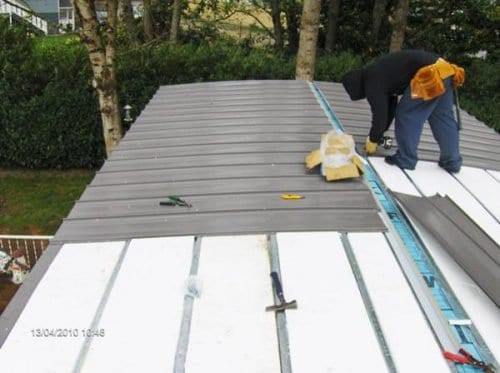When it comes to roofing options, homeowners often find themselves seeking durable and long-lasting solutions. One increasingly popular choice is installing a metal roof over a rubber roof. This approach combines the durability and sustainability of metal with the protective properties of rubber. In this article, we will explore the benefits, considerations, and step-by-step process of installing a metal roof over a rubber roof.

Benefits of Installing a Metal Roof Over a Rubber Roof:
Enhanced Durability: One of the primary advantages of installing this roof is the enhanced durability it provides. Metal roofs are known for their longevity and ability to withstand harsh weather conditions, such as heavy rain, strong winds, and snowfall. By installing a metal roof over an existing rubber roof, you add an extra layer of protection to your home, increasing its resistance to damage caused by environmental factors.
Energy Efficiency: Metal roofs have excellent energy-saving properties. They reflect a significant amount of solar radiation, reducing heat absorption into the house during hot summer months. This helps maintain a comfortable indoor temperature, reducing the reliance on air conditioning and lowering energy costs. By installing a metal roof over a rubber roof, you can enjoy improved energy efficiency, leading to long-term savings on utility bills.
Considerations before Installing a Metal Roof Over a Rubber Roof:
Structural Integrity: Before proceeding with the installation, it is crucial to assess the structural integrity of the existing rubber roof. The rubber roof should be in good condition, without any major issues such as leaks, rotting, or sagging. If there are underlying problems with the rubber roof, it is advisable to address them before installing the metal roof to ensure a stable and long-lasting roofing system.
Weight Considerations: Metal roofs are generally heavier than rubber roofs. Therefore, it is essential to evaluate whether the existing structure can support the additional weight of a metal roof. Consultation with a professional roofing contractor or a structural engineer is highly recommended to determine if any modifications or reinforcements are necessary.
Installation Process: Step-by-Step Guide
Step 1: Inspection and Preparation
Begin by inspecting the rubber roof for any damage or irregularities. Ensure that it is clean and free of debris. Repair any existing issues, such as leaks or punctures. Prepare the surface by removing loose materials and applying a primer if required.
Step 2: Installing Furring Strips
Furring strips are wooden or metal strips that create a raised surface for the metal roof panels. Install them parallel to the eaves, following the slope of the roof. Ensure proper spacing between the strips to facilitate proper ventilation and prevent moisture buildup.
Step 3: Installing Underlayment
Next, apply an underlayment over the furring strips. A self-adhesive waterproofing membrane or synthetic underlayment is commonly used for this purpose. The underlayment acts as an additional barrier against water infiltration and helps to protect the rubber roof.
Step 4: Installing the Metal Roof Panels
Begin installing the metal roof panels from the eaves upwards. Secure them to the furring strips using appropriate fasteners, such as screws or nails. Follow the manufacturer’s instructions for proper installation techniques, including overlap and alignment.
Step 5: Finishing Touches
Complete the installation by installing flashing around roof penetrations, such as chimneys or vents, to ensure a watertight seal. Inspect the entire roof for any loose fasteners or gaps, and make necessary adjustments. Finally, clean the roof surface from any debris and check for proper drainage.
Conclusion:
Installing a metal roof over a rubber roof provides homeowners with a durable and sustainable solution. The combination of metal’s longevity and rubber’s protective properties creates a robust roofing system that can withstand various weather conditions. Before proceeding with the installation, it is essential to assess the structural integrity and weight-bearing capacity of the existing roof. By following the step-by-step guide, homeowners can successfully install a metal roof over a rubber roof, enhancing their home’s durability and energy efficiency while enjoying long-term cost savings.



Leave a Reply